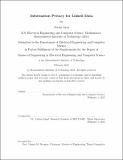Information privacy for linked data
Author(s)
Aron, Yotam
DownloadFull printable version (537.7Kb)
Other Contributors
Massachusetts Institute of Technology. Department of Electrical Engineering and Computer Science.
Advisor
Lalana Kagal.
Terms of use
Metadata
Show full item recordAbstract
As data mining over massive amounts of linked data becomes more and more prevalent in research applications, information privacy becomes a more important issue. This is especially true in the biological and medical fields, where information sensitivity is high. Previous experience has shown that simple anonymization techniques, such as removing an individual's name from a data set, are inadequate to fully protect the data's participants. While strong privacy guarantees have been studied for relational databases, these are virtually non-existent for graph-structured linked data. This line of research is important, however, since the aggregation of data across different web sources may lead to privacy leaks. The ontological structure of linked data especially aids these attacks on privacy. The purpose of this thesis is two-fold. The first is to investigate differential privacy, a strong privacy guarantee, and how to construct differentially-private mechanisms for linked data. The second involves the design and implementation of the SPARQL Privacy Insurance Module (SPIM). Using a combination of well-studied techniques, such as authentication and access control, and the mechanisms developed to maintain differential privacy over linked data, it attempts to limit privacy hazards for SPARQL queries. By using these privacy-preservation techniques, data owners may be more willing to share their data sets with other researchers without the fear that it will be misused. Consequently, we can expect greater sharing of information, which will foster collaboration and improve the types of data that researchers can have access to.
Description
Thesis: M. Eng., Massachusetts Institute of Technology, Department of Electrical Engineering and Computer Science, 2013. This electronic version was submitted by the student author. The certified thesis is available in the Institute Archives and Special Collections. Cataloged from student-submitted PDF version of thesis. Includes bibliographical references (pages 77-79).
Date issued
2013Department
Massachusetts Institute of Technology. Department of Electrical Engineering and Computer SciencePublisher
Massachusetts Institute of Technology
Keywords
Electrical Engineering and Computer Science.